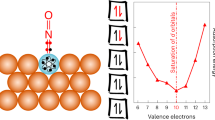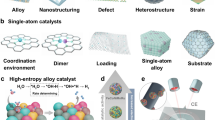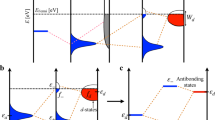Abstract
The rational design of pure and alloy metal catalysts from fundamental principles has the potential to yield catalysts of greatly improved activity and selectivity. A promising area of research concerns the role that near-surface alloys (NSAs) can play in endowing surfaces with novel catalytic properties. NSAs are defined as alloys wherein a solute metal is present near the surface of a host metal in concentrations different from the bulk; here we use density functional theory calculations to introduce a new class of these alloys that can yield superior catalytic behaviour for hydrogen-related reactions. Some of these NSAs bind atomic hydrogen (H) as weakly as the noble metals (Cu, Au) while, at the same time, dissociating H2 much more easily. This unique set of properties may permit these alloys to serve as low-temperature, highly selective catalysts for pharmaceuticals production and as robust fuel-cell anodes.
This is a preview of subscription content, access via your institution
Access options
Subscribe to this journal
Receive 12 print issues and online access
$259.00 per year
only $21.58 per issue
Buy this article
- Purchase on Springer Link
- Instant access to full article PDF
Prices may be subject to local taxes which are calculated during checkout




Similar content being viewed by others
References
Somorjai, G. A. Introduction to Surface Chemistry and Catalysis (Wiley, New York, 1994).
Chorkendorff, I. & Niemantsverdriet, J. W. Concepts of Modern Catalysis and Kinetics (Wiley, Weinheim, 2003).
Besenbacher, F. et al. Design of a surface alloy catalyst for steam reforming. Science 279, 1913–1915 (1998).
Jacobsen, C. J. H. et al. Catalyst design by interpolation in the periodic table: bimetallic ammonia synthesis catalysts. J. Am. Chem. Soc. 123, 8404–8405 (2001).
Zambelli, T., Wintterlin, J., Trost, J. & Ertl, G. Identification of the “active sites” of a surface-catalyzed reaction. Science 273, 1688–1690 (1996).
Xu, Z. et al. Size-dependent catalytic activity of supported metal-clusters. Nature 372, 346–348 (1994).
Sinfelt, J. H. Bimetallic Catalysts: Discoveries, Concepts, and Applications (Wiley, New York, 1983).
Nielsen, L. P. et al. Initial growth of Au on Ni(110): surface alloying of immiscible metals. Phys. Rev. Lett. 71, 754–757 (1993).
Schlapka, A., Lischka, M., Groß, A., Käsberger, U. & Jakob, P. Surface strain versus substrate interaction in heteroepitaxial metal layers: Pt on Ru(0001). Phys. Rev. Lett. 91, 016101 (2003).
Hwu, H. H., Eng, J. Jr. & Chen, J. G. Ni/Pt(111) bimetallic surfaces: unique chemistry at monolayer Ni coverage. J. Am. Chem. Soc. 124, 702–709 (2002).
Klötzer, B., Unterberger, W. & Hayek, K. Adsorption and hydrogenation of CO on Pd(111) and Rh(111) modified by subsurface vanadium. Surf. Sci. 532–535, 142–147 (2003).
Hansen, P. L. et al. Atom-resolved imaging of dynamic shape changes in supported copper nanocrystals. Science 295, 2053–2055 (2002).
Mitsui, T., Rose, M. K., Fomin, E., Ogletree, D. F. & Salmeron, M. Dissociative hydrogen adsorption on palladium requires aggregates of three or more vacancies. Nature 422, 705–707 (2003).
Studer, M., Blaser, H. & Exner, C. Enantioselective hydrogenation using heterogeneous modified catalysts: an update. Adv. Synth. Catal. 345, 45–65 (2003).
Cortright, R. D., Davda, R. R. & Dumesic, J. A. Hydrogen from catalytic reforming of biomass-derived hydrocarbons in liquid water. Nature 418, 964–967 (2002).
Huber, G. W., Shabaker, J. W. & Dumesic, J. A. Raney Ni–Sn catalyst for H2 production from biomass-derived hydrocarbons. Science 300, 2075–2077 (2003).
Deluga, G. A., Salge, J. R., Schmidt, L. D. & Verykios, X. E. Renewable hydrogen from ethanol by autothermal reforming. Science 303, 993–997 (2004).
Turner, J. A. A realizable renewable energy future. Science 285, 687–689 (1999).
Schlapbach, L. & Züttel, A. Hydrogen-storage materials for mobile applications. Nature 414, 353–358 (2001).
Greeley, J., Nørskov, J. K. & Mavrikakis, M. Electronic structure and catalysis on metal surfaces. Ann. Rev. Phys. Chem. 53, 319–348 (2002).
Nørskov, J. K. et al. Universality in heterogeneous catalysis. J. Catal. 209, 275 (2002).
Xu, Y., Ruban, A. V. & Mavrikakis, M. The adsorption and dissociation of O2 on Pt–Co and Pt–Fe alloys. J. Am. Chem. Soc. 126, 4717–4725 (2004).
Michaelides, A. et al. Identification of general linear relationships between activation energies and enthalpy changes for dissociation reactions at surfaces. J. Am. Chem. Soc. 125, 3704–3705 (2003).
Ruban, A. V., Skriver, H. L. & Nørskov, J. K. Surface segregation energies in transition-metal alloys. Phys. Rev. B 59, 15990–16000 (1999).
Hugenschmidt, M. B., Ruff, M., Hitzke, A. & Behm, R. J. Rotational epitaxy vs. missing row reconstruction: Au/Cu/Au(110). Surf. Sci. 388, L1100–L1106 (1997).
Konvicka, C. et al. Surface and subsurface alloy formation of vanadium on Pd(111). Surf. Sci. 463, 199–210 (2000).
Okada, M., Nakamura, M., Moritani, K. & Kasai, T. Dissociative adsorption of hydrogen on thin Au films grown on Ir(111). Surface Science 523, 218–230 (2003).
Lundgren, E., Leonardelli, G., Schmid, M. & Varga, P. A misfit structure in the Co/Pt(111) system studied by scanning tunnelling microscopy and embedded atom method calculations. Surf. Sci. 498, 257–265 (2002).
Lim, B. S., Rahtu, A. & Gordon, R. G. Atomic layer deposition of transition metals. Nature Mater. 2, 749–754 (2003).
Finke, R. G. in Metal Nanoparticles: Synthesis, Characterization, and Applications (eds Feldheim, D. L. & Foss, C. A. Jr) 17–54 (Marcel Dekker, New York, 2002).
Debe, M. in Handbook of Fuel Cells-Fundamentals, Technology, and Applications (eds. Vielstich, W., Lamm, A. & Gasteiger, H. A.) 576–589 (Wiley, New York, 2003).
Mavrikakis, M., Hammer, B. & Nørskov, J. K. Effect of strain on the reactivity of metal surfaces. Phys. Rev. Lett. 81, 2819–2822 (1998).
Hammer, B. & Nørskov, J. K. in Chemisorption and Reactivity on Supported Clusters and Thin Films (eds Lambert, R. M. & Pacchioni, G.) 285–351 (Kluwer, Netherlands, 1997).
Rodriguez, J. A. & Goodman, D. W. The nature of the metal–metal bond in bimetallic surfaces. Science 257, 897–903 (1992).
Hammer, B. & Nørskov, J. K. Why gold is the noblest of all metals. Nature 376, 238–240 (1995).
Hammer, B. & Nørskov, J. K. Electronic factors determining the reactivity of metal surfaces. Surf. Sci. 343, 211–220 (1995).
Beutl, M. et al. There is a true precursor for hydrogen adsorption after all: the system H2/Pd(111) + subsurface V. Chem. Phys. Lett. 342, 473–478 (2001).
Hammer, B., Hansen, L. B. & Nørskov, J. K. Improved adsorption energetics within density-functional theory using revised Perdew–Burke–Ernzerhof functionals. Phys. Rev. B 59, 7413–7421 (1999).
Perdew, J. P. et al. Atoms, molecules, solids, and surfaces: applications of the generalized gradient approximation for exchange and correlation. Phys. Rev. B 46, 6671–6687 (1992).
Henkelman, G., Uberuaga, B. P. & Jónsson, H. A climbing image nudged elastic band method for finding saddle points and minimum energy paths. J. Chem. Phys. 113, 9901–9904 (2000).
CRC Handbook of Chemistry and Physics (CRC, New York, 1996).
Acknowledgements
NSF supported this work through a pre-doctoral fellowship (J.G.) and a CAREER award (M.M.). Additional partial support was provided by a DOE-BES Catalysis Science Grant. Calculations were made on DOE-NERSC, NPACI and MSCF-PNNL resources. We thank A. Gokhale, M.-S. Han, A. Nilekar and Y. Xu for their help, and F. Besenbacher, J. Chen, J. Dumesic and J. Nørskov for discussions.
Author information
Authors and Affiliations
Corresponding author
Ethics declarations
Competing interests
The authors declare no competing financial interests.
Supplementary information
Supplementary Information, Fig. S1
Supplementary Information, Table S1 (PDF 222 kb)
Supplementary Information, Table S2
Supplementary Information, Table S3
Supplementary Information, Table S4
Supplementary Information, Table S5
Supplementary Information, Note 1
Supplementary Information, Note 2
Supplementary Information, Note 3
Supplementary Information, Note 4
Rights and permissions
About this article
Cite this article
Greeley, J., Mavrikakis, M. Alloy catalysts designed from first principles. Nature Mater 3, 810–815 (2004). https://doi.org/10.1038/nmat1223
Received:
Accepted:
Published:
Issue Date:
DOI: https://doi.org/10.1038/nmat1223
This article is cited by
-
Rapid mapping of alloy surface phase diagrams via Bayesian evolutionary multitasking
npj Computational Materials (2023)
-
Electrified water treatment: fundamentals and roles of electrode materials
Nature Reviews Materials (2023)
-
Synthetic tuning stabilizes a high-valence Ru single site for efficient electrolysis
Nature Synthesis (2023)
-
Strategies for Designing the Catalytic Environment Beyond the Active site of Heterogeneous Supported Metal Catalysts
Topics in Catalysis (2023)
-
Adsorbate chemical environment-based machine learning framework for heterogeneous catalysis
Nature Communications (2022)



